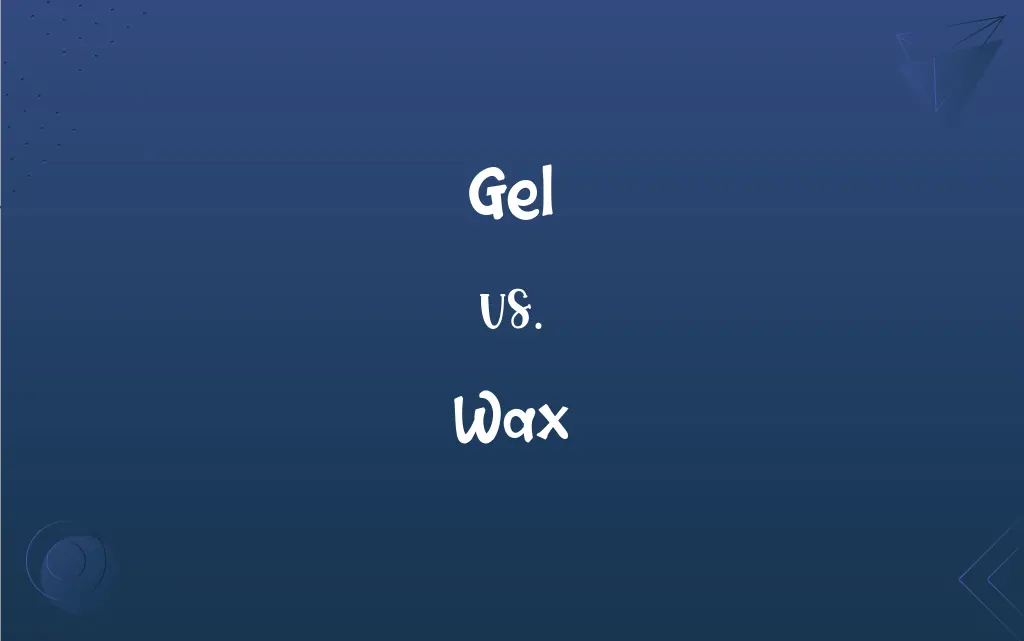Gel vs. Wax: What's the Difference?
Edited by Aimie Carlson || By Harlon Moss || Updated on July 9, 2024
Gel is a thick, jelly-like substance, often used for styling hair or in cosmetics, while wax is a solid or semi-solid substance derived from fats or oils, used for various purposes like sealing or styling.

Key Differences
Gel is a colloidal suspension of particles, and it's known for its semi-solid, jelly-like consistency. In cosmetics and personal care, gel provides a sleek, wet look when applied. Wax, on the other hand, is derived from fats or oils, either natural or synthetic. It's known for its ability to mold and shape, especially in terms of hair styling.
One can often find gel as a medium in cosmetic products, such as hair gels, shower gels, or gel nail polish. These products capitalize on gel's consistent and spreadable nature. Wax has diverse applications beyond cosmetics, such as in candles, car polishes, and even in some foods. Its versatility stems from its adaptable properties that can be hard like a candle or soft like lip balm.
Gel products tend to dry quickly, offering a hold that is stiff but can be easily rinsed with water. This makes gel-based hair products popular for those wanting a strong hold. Wax products for hair offer more of a pliable hold, allowing for restyling throughout the day. They also provide a matte or shiny finish, depending on the product.
When considering the base of the products, gels are primarily water-based, which accounts for their easy rinse properties. Wax, however, can be made from various bases, including petroleum, beeswax, or plant-based sources, making them more resistant to water.
In the realm of skincare, gels offer a lightweight consistency ideal for oilier skin types, providing hydration without heaviness. Wax, when found in skincare, often serves as a barrier, locking in moisture and protecting the skin, such as in lip balms or heavy-duty moisturizers.
ADVERTISEMENT
Comparison Chart
Consistency
Jelly-like, semi-solid
Solid or semi-solid
Primary Base
Often water-based
Derived from fats or oils (e.g., beeswax, paraffin)
Common Uses
Hair styling, cosmetics, pharmaceuticals
Hair styling, candles, sealants, polishes
Finish (Hair)
Typically provides a wet, shiny look with a stiff hold
Can provide matte to shiny finishes with a flexible hold
Rinse properties
Easily rinsed with water due to its water-based nature
More resistant to water, often needing shampoo or soap for removal
ADVERTISEMENT
Gel and Wax Definitions
Gel
A semi-solid, jelly-like substance.
She applied the gel to soothe her sunburned skin.
Wax
A malleable substance derived from fats or oils.
She used beeswax to make homemade candles.
Gel
A product used for hair styling.
He used some gel to spike up his hair.
Wax
A material used in hair removal treatments.
She scheduled a wax appointment before her vacation.
Gel
A thick liquid form used in cosmetics or medications.
She prefers gel-based nail polish for its durability.
Wax
A product used to style hair, offering a pliable hold.
He used some wax to give his hair a textured look.
Gel
A colloid where the dispersed phase is combined with the continuous phase.
The gel in the petri dish was prepared for the experiment.
Wax
To increase in size, number, or strength.
The moon waxes and wanes in its lunar phases.
Gel
A substance that has undergone gelation.
The chef waited for the gelatin mixture to gel before serving.
Wax
A substance used to polish or protect surfaces.
He applied some wax to his car for that extra shine.
Gel
A colloid in which the disperse phase has combined with the dispersion medium to produce a semisolid material, such as a jelly.
Wax
Any of various natural, oily or greasy heat-sensitive substances, consisting of hydrocarbons or esters of fatty acids that are insoluble in water but soluble in nonpolar organic solvents.
Gel
See gelatin.
Wax
Beeswax.
FAQs
What is wax?
Wax is a solid or semi-solid substance derived from fats or oils, used in various applications from sealing to styling.
Can wax be used for hair styling?
Yes, hair wax is used for styling and provides a flexible, often matte finish.
What is gel?
Gel is a thick, jelly-like substance often used in cosmetics and hair styling.
Are all gels used for hair styling?
No, gels have various uses, including in cosmetics, pharmaceuticals, and more.
Are gels water-soluble?
Most gels, especially those for hair, are water-based and easily soluble in water.
Can gels be used in cooking?
Some gels, like gelatin, are used in cooking to give dishes a jelly-like consistency.
Do gels always provide a shiny finish?
Many hair gels provide a shiny, wet look, but not all gels have this finish.
How do you remove gel from hair?
Most hair gels can be easily rinsed out with water due to their water-based nature.
Why is wax used in car polishes?
Wax provides a protective layer and shine to surfaces, making it ideal for car polishes.
Is wax always solid?
No, wax can be solid, semi-solid, or even liquid at higher temperatures.
Are candles made from wax?
Yes, many candles are made from wax, like paraffin or beeswax.
Can gels be used in skincare?
Yes, gels offer a lightweight consistency ideal for some skincare products.
What is the primary base for most gels?
Most gels are water-based.
What's a common natural source for wax?
Beeswax is a commonly used natural wax.
How is wax produced naturally?
Bees produce beeswax, and some plants produce waxes as well.
What's the main difference between gel and wax in hair products?
Gel provides a wet, often shiny and stiff hold, while wax offers flexibility and a matte or shiny finish.
How do gels and wax differ in hair styling?
Gels typically offer a stiffer, shiny finish, while waxes provide a flexible, often matte finish.
Can wax be used in cosmetics?
Yes, wax is often found in products like lip balms and heavy moisturizers.
Is gel nail polish made from actual gel?
Gel nail polish has a gel-like consistency and often requires UV light to set.
Can wax be synthetic?
Yes, there are synthetic waxes derived from petroleum and other sources.
About Author
Written by
Harlon MossHarlon is a seasoned quality moderator and accomplished content writer for Difference Wiki. An alumnus of the prestigious University of California, he earned his degree in Computer Science. Leveraging his academic background, Harlon brings a meticulous and informed perspective to his work, ensuring content accuracy and excellence.
Edited by
Aimie CarlsonAimie Carlson, holding a master's degree in English literature, is a fervent English language enthusiast. She lends her writing talents to Difference Wiki, a prominent website that specializes in comparisons, offering readers insightful analyses that both captivate and inform.































































